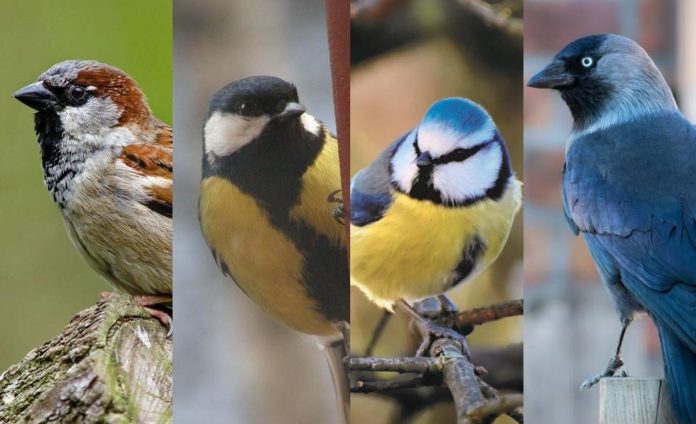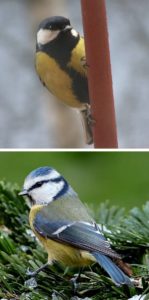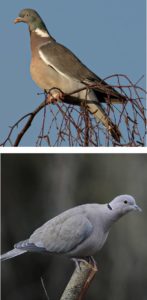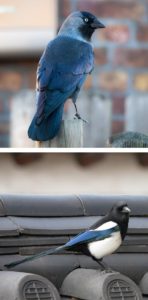
Backyards and home gardens are the territories of many wild birds. Did you know that almost 100 different bird species have been spotted in Dutch gardens?
Of course, not all of them are your regular garden birds. Many of them only show up occasionally – resting after a long flight, sheltering from bad weather or tracking some garden mouse.
Indeed, many are quite common and can become everyday visitors. Great and blue tits, blackbirds, robins and sparrows thrive in urban gardens, where they find the food and shelter they need. If you haven’t done so, you can read more about why gardens are an important habitat for birds and what we can do to improve them in my previous article.
Some (very) common birds
So, you might be wondering “how do I know which bird is visiting my garden?” or “they all look the same to me!”. Let me introduce some of the most common garden birds and how to recognise them:
Great tit

The great-tit might be the most frequent visitor to garden bird feeders. This small bird has a yellow chest (brighter during spring and summer) with a black stripe running down the body. The head is also black with white cheeks. Great tits are often seen flying from tree to tree in groups of various sizes, often mixed with blue-tits. They nest in tree holes and cavities and also regularly use nest-boxes.
Blue tit
Blue tits are similar to great tits (they are related species), but are somewhat smaller and look “lighter”. The easiest way to tell them apart is looking for their striking blue heads; their wings also have a blueish tint. They are quite acrobatic birds, often perching upside-down while feeding. Blue tits are also very common in bird feeders and nest boxes.
House Sparrow

(photos: betexion & OldieFan – Pixabay)
House sparrows are very sociable birds, forming large flocks throughout the whole year. They have a mix of brown and grey colours; the males have a characteristic grey cap-like feature on their heads and black upper chests. They are often seen feeding on the ground or cheerfully hopping around.
Robin
The bright orange-red chest is the robin’s main calling card, in sharp contrast with the rest of its dull-coloured body. Robins are not shy birds: they are often seen foraging for food on the ground or heard singing perched on a low branch of a shrub or tree. They prefer gardens that have low shrubs.
Blackbird
The name says it all, and blackbirds are, well… black. Actually only the males are totally black, with a bright yellow beak; females are dark brown with a darker beak. They sing a beautiful, melodious song, particularly at dawn. Blackbirds are often seen going through fallen leaves looking for bugs, worms and seeds.
Woodpigeon

Although they might seem the same, woodpigeons are not your regular city pigeons (the latter are also called rock pigeons or rock doves). Woodpigeons are bigger and bulkier and have a clear white patch on the neck. When their wings are open, they have an obvious white band running across them. In cities, woodpigeons usually do not form such large flocks as rock pigeons. They built their nest among the tree’s branches, and not in colonies as the rock pigeon.
Collared dove
Collared doves are smaller than pigeons, looking slimmer and lighter. Their plumage is almost entirely pale grey, apart from the black tail top and the black band on the back of the neck – from which they get their English name – Collared doves nest in trees, just like woodpigeons.
Jackdaw

Jackdaws are small crows, roughly pigeon-sized. They are entirely black, with a distinct metallic grey patch on the back of the head and neck. Their eyes are blue, which also tells them apart from other crows. Jackdaws are very common in Eindhoven and can be often heard “chatting” among them; they are, however, extremely intelligent birds. During winter they congregate in large flocks before sunset to spend the night in communal “dormitories”.
Magpie
Their very long tail, their black and white body, and their metallic blue and green reflections make magpies easily distinguishable from every other bird. They are related to crows and ravens, which means they are also very smart; and have a reputation for enjoying shiny objects. Magpies build large nests near the treetops which last from one year to the next. When the trees are leafless (such as now), the nests stand out: lookup and lookout during your next walk outside!
These are far from being the only birds that visit our gardens but are some of the most common in Eindhoven. I hope this short introduction helps you next time you see a wild bird outside your window.
Counting garden birds – De Nationale Tuinvogeltelling weekend
Next weekend (29, 30 & 31 of January), the Nationale Tuinvogeltelling takes place in the Netherlands! During the “National Garden Bird Count” everyone in the Netherlands is invited to count the birds that visit their gardens, backyards, balconies and terraces (for those who know it, it’s quite similar to the U.K.’s RSPB Big Garden Birdwatch).
It’s a simple, fun and family-friendly initiative, happening every year since 2001. Taking part and sending in your observations (it only takes 30 mins) is important for assessing how urban birds are doing, and if some species are decreasing in numbers or distribution. It’s also totally Corona-proof since you do it from your own home.

During the Nationale Tuinvogeltelling of 2020, more than 90.000 persons took part. More than 1,5 million garden birds were counted all over the country! The house sparrows, the great tits and the blue tits were the most common birds. Here in Eindhoven, 743 persons joined in, counting more than 11.000 wild birds. The house-sparrow and the great tit were also the two most counted birds, but the third place went to… the jackdaw! If you want to explore more or find out how it was in your neighbourhood, check the Tuivogeltelling website (Dutch.)
Participating is really easy: just go to the www.mijntuinvogeltelling.nl/home, and register by clicking “Doe alvast mee”. Unfortunately, all the pages are in Dutch only; however, if you want to join the count, but are struggling with the Dutch language, let me know, and I’ll help you out!
Have fun! You’ll realize that wildlife is literally at your doorstep!
PS: Want to know more about which birds visit your garden, balcony or backyard? Have a peculiar winged visitor you cannot identify? Feel free to ask me via facebook or email (nuno @ wild-eindhoven.com).
For Eindhoven News: Nuno Curado
A wildlife ecologist, fascinated with urban nature: the wild animals and plants that live with us in the cities! He is the person behind Wild Eindhoven: a one-person company on a mission to help everyone discover nature in the city, from city parks to our home balconies!
















Hi!
Did my garden bird count this morning! In my 30 min count, my back garden was visited by 2 great tits, 2 wood pigeons, 1 robin and 1 collared dove! No blue tits, although they are regular visitors to my bird feeders.
Hope you all fun counting birds this weekend!
Nuno Curado
I have just moved here from the Southern hemisphere. I am eager to attract birds to my tiled back garden. I will plant flowers to attract insects. What do the birds prefer in feeders? Thanks in advance.
Hello Melani,
It’s great that you will be doing that, I hope your garden attract lots of local wildlife! 🙂
As for your question, I invite you to read my other article, where I mention just that -» https://eindhovennews.com/features/2021/01/birds-in-your-backyard-giving-them-a-helping-hand/
Wild regards,
Nuno